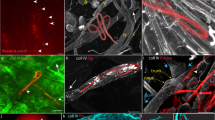Abstract
Larvae ofToxocara vitulorum hatched and migrated in the tissues of normal mice. Larvae survived in reasonable numbers, particularly in the liver and, to a lesser extent, in the lungs and kidneys, for at least 4–7 days and in muscles, albeit only in low numbers, for at least 3 weeks. Oral infection of mice on three or more occasions withT. vitulorum eggs induced protection against a challenge infection with eggs ofT. vitulorum. Prior parenteral immunization of mice with a variety ofT. vitulorum soluble antigens (extracts, excretions/secretions, or perienteric fluid and their fractions) from adult parasites and/or infective larvae induced statistically significant protection against infection. The most effective protective immunogens were three or more injections with perienteric fluid from adults (100% protection) and excretions/secretions from infective larvae ofT. vitulorum (>92% protection).
Similar content being viewed by others
References
Abo-Shehada MN, Al-Zubaidy BA, Herbert IV (1991) Acquired immunity toToxocara canis in mice. Vet Parasitol 38:289–298
Barriga OO (1988) A critical look at the importance, prevalence and control of toxocariasis and the possibilities of immunological control. Vet Parasitol 29:195–234
Bindseil E (1970) Immunity toAscaris suum: 3. The importance of the gut for immunity in mice. Acta Pathol Microbiol Scand [B] 78:183–190
Chauhan PPS, Pande BP (1972) Migratory behaviour ofNeoascaris vitulorum larvae in albino mice. Indian J Exp Biol 10:193–200
Christie JF, Fraser EM, Kennedy MW (1992) Comparison between MHC-restricted antibody repertoire toAscaris antigens in adjuvant-assisted immunization or infection. Parasite Immunol 14:59–73
Concepcion JE, Barriga OO (1985) Transfer of infection-induced protection toToxocara canis in a mouse model. Vet Immunol Immunopathol 9:371–382
Herlich H (1953) On the migratory behaviour of the larvae ofNeoascaris vitulorum (Goeze 1782), Travassos 1927 in white mice. Proc Helminthol Soc Wash 20:124–126
Izzat NN, Olson JJ (1970) Resistance of mice toToxocara canis: effect of prechallenge infections and injection of worm extracts. Can J Zool 48:1063–1066
Kabat EA, Mayer MM (1961) Experimental immunochemistry. Charles C. Thomas, Springfield, Illinois
Lowenstein MD (1981) Quantitative studies on the migration of larvae ofToxocara canis in the definitive host after a single reinfection. Inaugural dissertation, Tierärztliche Hochschule, Hannover
Olson LJ (1962) Organ distribution ofToxocara canis larvae in normal mice and in mice previously infected withToxocara. Tex Rep Biol Med 20:651–656
Parsons JC, Grieve RB (1990a) Effect of egg doses and host genotype on liver trapping in murine larval toxocariasis. J Parasitol 76:53–58
Parsons JC, Grieve RB (1990b) Kinetics of liver trapping of infective larvae in murine toxocariasis. J Parasitol 76:529–536
Rajapakse RPVJ, Vasanthathilake VWSM, Lloyd S, Fernado ST (1992) Collection of eggs and hatching and culturing second-stage larvae ofToxocara vitulorum in vitro. J Parasitol (in press)
Roberts JA (1990a) The egg production ofToxocara vitulorum in Asian buffalo (Bubalis bubalis). Vet Parasitol 37:113–120
Roberts JA (1990b) The life cycle ofToxocara vitulorum in Asian buffalo (Bubalis bubalis). Int J Parasitol 20:833–840
Roberts JA, Fernando ST, Sivanathan S (1990)Toxocara vitulorum in the milk of buffalo (Bubalis bubalis) cows. Res Vet Sci 49:289–291
Snedecor GW, Cochran G (1976) Statistical methods. Iowa State University Press, Ames, Iowa
Sprent JFA (1953) On the migratory behaviour of the larvae of variousAscaris spp. in white mice: II. Longevity of encapsulated larvae and their resistance to freezing and putrefaction. J Infect Dis 92:114–117
Sprent JFA, Chen HH (1949) Immunological studies in mice infected with the larvae ofAscaris lumbricoides: I. Criteria of immunity and immunizing effect of isolated worm tissues. J Infect Dis 84:11–124
Stromberg BE, Soulsby EJL (1977)Ascaris suum: protective immunity in pigs immunized with products from eggs and larvae. Int J Parasitol 7:287–291
Taffs LF (1964) Immunological studies on experimental infection of pigs withAscaris suum Goeze, 1782: III. The antibody response and acquired immunity. J Helminthol 38:129–150
Urban JF, Romanowski RD (1985)Ascaris suum: protective immunity in pigs immunized with products from eggs and larvae. Exp Parasitol 60:245–254
Urban JF, Tromba FG (1982) Development of immune responsiveness toAscaris suum antigens in pigs vaccinated with ultraviolet-attenuated eggs. Vet Immunol Immunopathol 3:399–409
Warren EG (1971) Observations on the migration and development ofToxocara vitulorum in natural and experimental hosts. Int J Parasitol 1:85–91
Author information
Authors and Affiliations
Rights and permissions
About this article
Cite this article
Amerasinghe, P.H., Rajapakse, R.P.V.J., Lloyd, S. et al. Antigen-induced protection against infection withToxocara vitulorum larvae in mice. Parasitol Res 78, 643–647 (1992). https://doi.org/10.1007/BF00931514
Accepted:
Issue Date:
DOI: https://doi.org/10.1007/BF00931514




